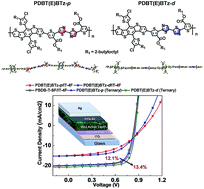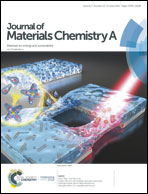Design of wide-bandgap polymers with deeper ionization potential enables efficient ternary non-fullerene polymer solar cells with 13% efficiency†
Abstract
Two regioisomeric wide-bandgap (WBG) polymers, PDBT(E)BTz-p and PDBT(E)BTz-d, with different nitrogen topologies along the conjugated backbone were developed and applied in non-fullerene polymer solar cells. Both polymers exhibit deeper ionization potential (IP) enabled by the synergistic electron-withdrawing effect of chlorine atoms and ester substituents. The effects of different nitrogen topologies on polymeric backbone linearity and optoelectronic and photovoltaic properties are systematically investigated. When blended with the electron acceptor IT-4F, the PDBT(E)BTz-p-based device delivers a PCE of 6.96% with a high VOC of 0.98 V and a low energy loss of 0.55 eV, while the PDBT(E)BTz-d-based device exhibits a higher PCE of 7.81% with an improved FF. Furthermore, PDBT(E)BTz-d is found to be effective as the third component in a binary PBDB-T-SF:IT-4F system to enhance device efficiencies from 12.1% for the binary device to 13.4% for the ternary device with 5 wt% PDBT(E)BTz-d relative to PBDB-T-SF. It is observed that an internal Förster resonance energy transfer (FRET) between PDBT(E)BTz-d and PBDB-T-SF gives rise to the improvement of external quantum efficiency and JSC. These results demonstrate that the WBG polymer featuring deeper IP can not only enhance the VOC but can also act as a sensitizer to transfer energy through the FRET mechanism toward highly efficient ternary PSCs. In addition, this contribution provides a new idea for the design and synthesis of conjugated polymers for organic electronics.



 Please wait while we load your content...
Please wait while we load your content...